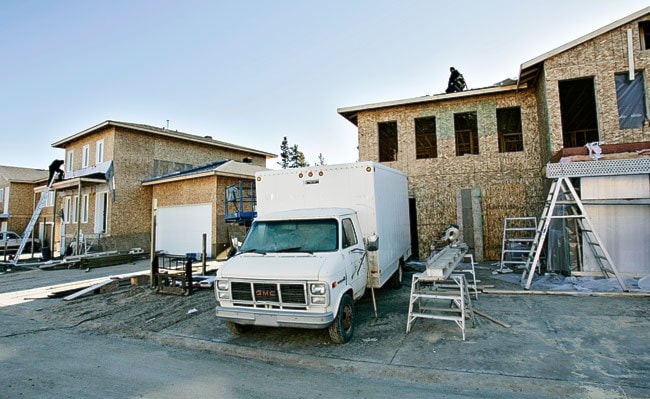Want to paint your house brick red?
If your neighbour’s house is already an auburn colour - forget it.
The two shades of paint are too similar, according to the city’s planning department.
Trim colour, garage size, driveway topping and house setbacks are also under the city’s control.
Whitehorse started tampering with home design as part of a larger effort to differentiate and “dignify” houses in newer subdivisions like Takhini North and Stan McCowan, said planner Kinden Kosick.
The city adopted the development zoning bylaws in 2008.
Since then, there have been mixed reviews.
Developers have complained the bylaws are too restrictive and that the design requirements drive up the cost of buying a house.
“I don’t like the extent to which the bylaw has gone to,” said developer Joel Hackney of Horizon Construction.
He thinks painting houses different colours is a good way to diversify homes. But it’s one of the few regulations he agrees with.
Requiring all homes to have a porch or to be closely abutting the street doesn’t make sense, he said.
“I guess the city has its vision of people sitting on the front porch in their rocking chair watching their kids playing in the streets,” he said.
“But the reality is that life isn’t like that now.
“I’m going along with these (requirements) because we have to, but I’m not necessarily happy with them.”
The extra frills cost homeowners more and slow down construction.
“It’s going to make it that much more difficult for first-time buyers to own a house,” said Hackney, explaining that the requirements could tack an additional $10,000 onto a home.
“They keep on adding these (requirements) and everybody complains about the price, but it’s not necessarily the contractors. It’s the city and YTG regulations.”
Requirements in the amended bylaw dictate, for instance, that a permit must be taken out before any vegetation on a lot can be removed.
A development officer must approve the colour choice of a house and at least 50 per cent of the front of a house must have a porch or a covered entrance.
In addition, houses need to be a maximum of six metres from the road.
That’s hardly enough space to even park your truck in the driveway, said councillor Doug Graham.
He and other councillors agree that the city shouldn’t be micromanaging developers.
Monday night, council voted down a set of amendments to the residential zoning bylaw.
“I don’t like these changes and I didn’t like the original bylaw,” said Graham. “The bylaw is too restrictive.”
“I can’t believe some of the petty little stuff we’re asking for here,” said councillor Florence Roberts.
With the amendments struck down, planners need to go back to the drawing board, said Kosick.
They’ll have to better explain the bylaw to councillors and come up with something more palatable.
“What we’re doing here isn’t new,” said Kosick, explaining that the regulations are found in other cities.
And the request for design standards came from residents themselves.
“In Takhini North, for instance, there was concern from residents that development around existing homes wouldn’t fit,” said Kosick.
“Design standards were a way of providing certainty of what the homes were going to look like and that they would fit in.”
Residents pointed to newer phases of Copper Ridge as an example of what they didn’t want - houses of similar colour with large garages.
“It’s good to encourage better design standards,” said Takhini North president Mark O’Brien.
But he’s skeptical of the development requirements the city has brought in.
They wouldn’t be needed, he said, if contractors didn’t buy up whole streets and plunk down homogenous-looking houses.
“One developer managed to snap up all the lots on Rhine Way and that’s why all the houses look similar.”
If the city had a fair land-lottery system, contractors wouldn’t be able to buy up whole tracts of land, he said.
O’Brien would prefer to see individuals developing these lots.
“It’s hard to see a contractor come in without any personal investment in a neighbourhood and then profit,” he said.
“It doesn’t necessarily lead to quality (homes).”
When contractors rule the market, the city can only put so many design restrictions in place to improve esthetics, he said.
“It’s quite disappointing that we took time as community members to ensure more progressive planning in our neighbourhood only to find the process subverted.”
Contact Vivian Belik at
vivianb@yukon-news.com
